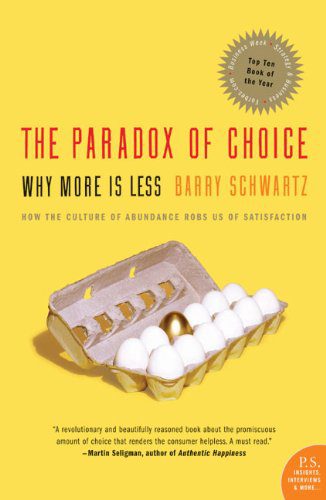In The Paradox of Choice–Why More Is Less, American psychologist Barry Schwartz explains why too much of a good thing has proven detrimental to our psychological and emotional well-being. Synthesizing current research in the social sciences, he makes the counterintuitive case that eliminating choices can greatly reduce the stress, anxiety, and busyness of our lives. Schwartz argues that freedom of choice has made us not freer but more paralyzed, not happier but more dissatisfied.
Chooser vs Picker
A chooser
A chooser is someone who thinks actively about the possibilities before making a decision. A chooser reflects on what’s important to him or her in life, what’s important about this particular decision, and what the short-and long-range consequences of the decision may be. A chooser makes decisions in a way that reflects awareness of what a given choice means about him or her as a person.
Picker
A picker does none of these things. With a world of choices rushing by like a music video, all a picker can do is grab this or that and hope for the best. Obviously, this is not such a big deal when what’s being picked is breakfast cereals. But decisions don’t always come at us with signs indicating their relative importance prominently attached. Unfortunately, the proliferation of choice in our lives robs us of the opportunity to decide for ourselves just how important any given decision is.
Maximizer
Choosing wisely begins with developing a clear understanding of your goals. And the first choice you must make is between the goal of choosing the absolute best and the goal of choosing something that is good enough. If you seek and accept only the best, you are a maximizer.
Maximizers need to be assured that every purchase or decision was the best that could be made. Yet how can anyone truly know that any given option is absolutely the best possible? The only way to know is to check out all the alternatives. A maximizer can’t be certain that she has found the best sweater unless she’s looked at all the sweaters. She can’t know that she is getting the best price unless she’s checked out all the prices. As a decision strategy, maximizing creates a daunting task, which becomes all the more daunting as the number of options increases.
Satisfiser
The alternative to maximizing is to be a satisficer. To satisfice is to settle for something that is good enough and not worry about the possibility that there might be something better. A satisficer has criteria and standards. She searches until she finds an item that meets those standards, and at that point, she stops. As soon as she finds a sweater that meets her standard of fit, quality, and price in the very first store she enters, she buys it—end of story. She is not concerned about better sweaters or better bargains just around the corner.
“To a maximizer, satisficers appear to be willing to settle for mediocrity, but that is not the case. A satisficer may be just as discriminating as a maximizer. The difference between the two types is that the satisficer is content with the merely excellent as opposed to the absolute best.”

1 Comment
Pingback: The Fear of a Better Option (FOBO) – Lanre Dahunsi